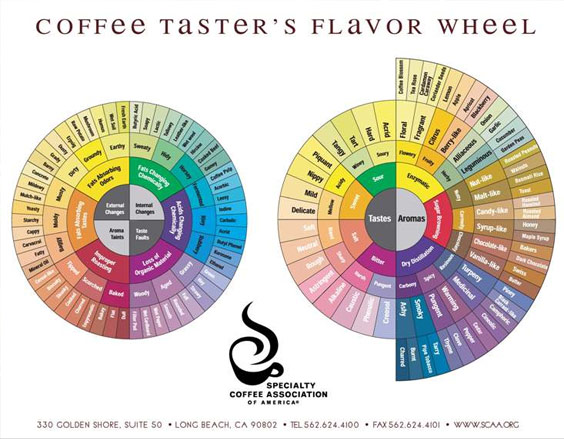The Specialty Coffee Association of America Coffee Tasters Flavor Wheel, which can be seen hanging in hundreds, if not thousands, of production roasteries and cupping labs throughout the world as both an art piece and sensory analysis tool, has been updated for the first time in its 21-year history since its remarkable initial development under former SCAA Director Ted Lingle.
The new Wheel was unveiled to members of the SCAA’s Roasters Guild during the inaugural Sensory Summit, held this past weekend on the campus of UC Davis. The Wheel — providing a striking, more modern visual representation of coffee characteristics — reflects three years of development and the SCAA’s collaboration with World Coffee Research, which also minutes ago released its long-anticipated Sensory Lexicon. Providing the sensory and language foundations for the new wheel, the Lexicon was developed by WCR through collaboration and research with some of the leading sensory scientists in the United States, as well as from cupping and sourcing professionals from the coffee industry.
“This is the largest and most collaborative piece of research on coffee flavor ever completed, inspiring a new set of vocabulary for industry professionals,” SCAA Chronicle Executive Editor Lily Kubota wrote in a piece published today. “This groundbreaking new tool will shift the way our industry thinks about and utilizes coffee flavor.”
We’ll have more in the WCR Lexicon in the coming weeks, but an overarching goal of the WCR project has been to help create a universal language for coffee based on scientific analysis, rather than relying on the well-established industry practice of measuring for qualitative value.
“In order to understand what causes and influences particular flavors in coffee, there must be a better tool for quantifying what those flavors actually are,” Kubota wrote of the SCAA’s interest in the ongoing project, which has involved hundreds of scientists and industry analysts. “What we call ‘flavor notes’ —and what scientists call ‘flavor attributes’ — in coffee are especially important here.”
The Lexicon currently contains 110 attributes — anything from pineapple or honey to cardboard or mold — each associated with a specific, widely available reference product. For example, the reference for “cherry” in the Lexicon is R.W. Knudsen Just Tart Cherry Juice. For “skunky,” the reference is “latex balloon.” In that way, the Lexicon can be a very useful compendium to the wheel in practical applications, even providing specific notes on how to prepare a reference sample. For “lime,” for example, the Lexicon instructs to “put 0.25 grams lime peel in a medium snifter. Cover.”
To be clear, the Lexicon and the Wheel exist independent of one another, although the former is the foundation for the latter. For the Wheel’s purposes, the SCAA presented the finished Lexicon to sensory scientists and coffee industry professionals for a follow-up study at UC Davis to determine appropriate groupings of individual characteristics that are now reflected in both the Lexicon and the Wheel. “This is the first time such a study has been used to organize descriptors on a flavor wheel, making the organization of the wheel as research-based as the Lexicon flavor attributes themselves,” Kubota wrote.
“We developed the Lexicon for our own purposes, but we realized this would have broader impacts for the industry and broader uses,” Neuschwander said of the ongoing collaboration with SCAA. “One of those things is having more agreement in the language of coffee. It’s not meant to be a global final word on how to describe coffee. But we think it’s the first of its kind.”
Neuschwander added that WCR is currently building a process that would allow people to submit additional characteristics that are underdeveloped or not currently represented in the Lexicon, leaving room for occasional updates to both the Lexicon and the Wheel.
Nick Brown
Nick Brown is the editor of Daily Coffee News by Roast Magazine.








Comment